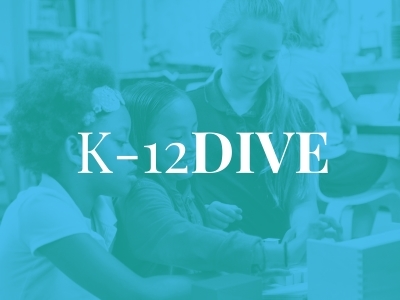How Schools Will Win the Education Revolution
Topics

Today’s learners face an uncertain present and a rapidly changing future that demand far different skills and knowledge than were needed in the 20th century. We also know so much more about enabling deep, powerful learning than we ever did before. Our collective future depends on how well young people prepare for the challenges and opportunities of 21st-century life.
In his new book THRIVE, author Grant Lichtman offers 3 pathways for schools to make themselves irresistible, enabling them to embrace the discomfort of change and growth.
Education is undergoing the most profound period of evolution in the last 150 years, just starting to feel the disruptive impacts of a world of radically greater consumer choice. A mere two decades ago, consumers bought what large producers of goods and services told us to buy. Today, around the globe and across virtually every sector of the economy, those tables have turned 180 degrees. Consumers say, “This is what I want, when I want it, where I want it,” and producers either create those products and services or they go out of business. This is the evolving world of Uber, not Yellow Cab; Amazon, not Sears; Schwab, not Lehman Brothers; Airbnb, not Hyatt; iTunes, not Sony Records; GrubHub, not Applebee’s.
Thankfully, most schools are not for-profit businesses, but schools are not immune from this fundamental change. Unlike businesses, many school systems haven’t traditionally had to compete for students. Twenty years ago in the United States, roughly 90 percent of students went to their neighborhood public school. Now that number in some cities and regions is 50 percent and dropping, and in some areas the curve is steepening, not flattening. And the number of school-age students is falling. Every indication is that in the future both public and private schools will increasingly compete for fewer students who have more choices.
Your school needs a powerful value proposition that shouts to families, “Pick us!” from all of the options they have.
Here’s the thing: Evolution is neither fair nor kind. It is just a force. During periods of evolution, individuals and species live and die based on their ability to adapt to new conditions. We are currently experiencing a period of global social, technological, economic, and information evolution more rapid than any in the history of humankind. These changing conditions are starting to dramatically impact our systems of education, as families with a radical menu of different options select learning experiences that they think will best prepare their students for a rapidly changing future.
These impacts are being felt by urban, rural, rich, poor, district, charter, and tuition-charging schools. I have visited and worked with underserved public districts in rural areas where the next school is 40 miles away and school consolidation would mean the loss of a critical community resource. And I have visited and worked with some of the wealthiest, blue-blooded East Coast boarding schools with huge endowments and a long line of students begging to attend. So far, I have not visited a school team that feels 100 percent safe from potential extinction 20 years from now.
Irresistible Schools
In my new book, THRIVE: How Schools Will Win the Education Revolution, I have captured what I have learned from visiting and working with more than 200 schools and districts over the last seven years; key ways that some schools are rising to meet this competitive challenge. There is great news. We know how to deal with these evolutionary pressures. Business schools and bookstores are packed with classes and shelves on how to not only survive but thrive in the face of these challenges, when competition forces or allows us to change.
In his book, This is Marketing, Seth Godin puts it in the simplest possible terms: “The heart and soul of a thriving enterprise is the irrational pursuit of becoming irresistible.” Your school needs a powerful value proposition that shouts to families, “Pick us!” from all of the options they have. When your school becomes “irresistible,” increasing its value proposition over time, it will have a greater chance of survival. Those schools that fail to boost their perceived value will tend toward failure.
And the even greater news? Your irresistible school of the future is in demand! It is both needed and wanted by parents and students who know that the traditional school model is not delivering all that they hope for in a school. You can change how your school approaches learning in ways that improve learning for more students! You can still deliver on what is required by law and college admission offices and create something unique that is both educationally profound and attracts families who share your vision. Your school can be the one around which passionate families rally because you have turned a remarkable vision for better learning outcomes into a delivered reality.
Three Pathways to Educational Irresistibility
In THRIVE, I dig into three proven, powerful meta-pathways that build “irresistibility.” The first is to clearly define and bring together the most important concepts in creating long-term success: value, strategy, and innovation. These are words you have heard loosely bandied about the education world for years. They are powerful words . . . when we know what they actually mean and how to use them. Together, they are the roots, trunk, branches, and nutrients of any organization that hopes to develop long-term sustainable success. The three form a symbiotic cycle: school communities find their powerful value proposition; strategies align tightly to those values; innovations align to those strategies and build enhanced value over time.
The second is to develop and use what I call the Five Big Tools of strategic change. There are more tools than this, but the five that I outline in the book are a great place to start. These tools are concrete, relatively simple ways for you and your school team to build both a comfort with and capacity for change that can improve learning and create more excitement about what your school has to offer. The most powerful of these is the Kotter model of organizational change. It provides a framework for moving from the realization that something big needs to be done to actually delivering on that change. In the book, I translate this time-tested tool into the language of how schools operate.
The third deals with engaging an evolving marketplace of “customers:” the families who have choices about how and where their kids will be educated. We find examples of this kind of effective, appropriate customer engagement in schools as well as in other businesses that are very different from schools. These organizations use powerful tools to understand what families really want and need; to align these wants and needs with practices of great learning; and to reimagine and reconstruct their organizations to be vastly more comfortable, eager, and able to respond to this crazy, changing world in which we live.
Evolution is, by nature, uncomfortable at best. Those individuals and organizations that continue to thrive are those that embrace the discomfort. In schools, this means we embrace the growth mindset that we know lies at the core of learning, that we ask of our students. I have tried, in this book, to make that path a bit smoother by sharing what we know works along with a ton of resources, activities, and exemplar schools that will help your school or district along this evolutionary arc.
Photo at top courtesy of Allison Shelley/The Verbatim Agency for American Education: Images of Teachers and Students in Action.




